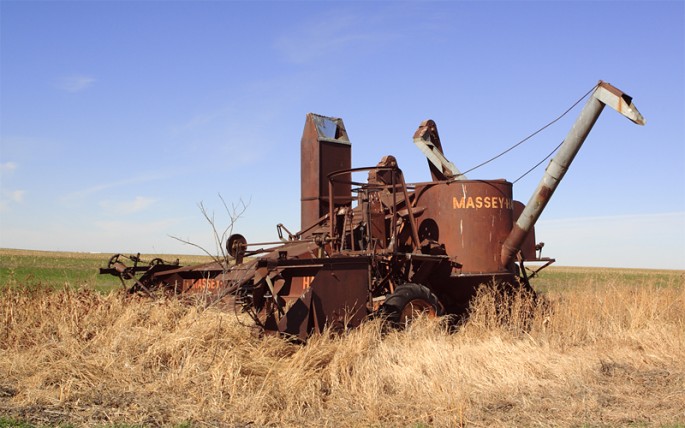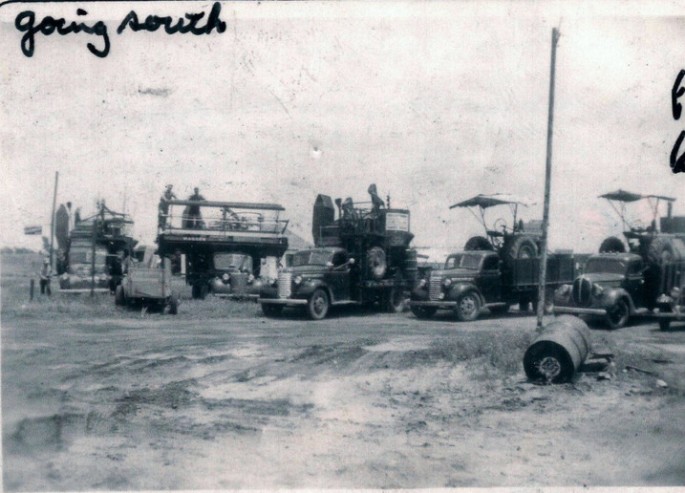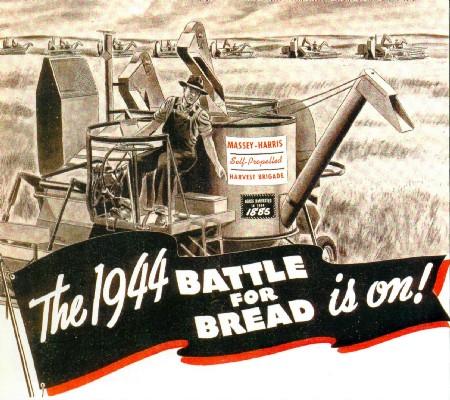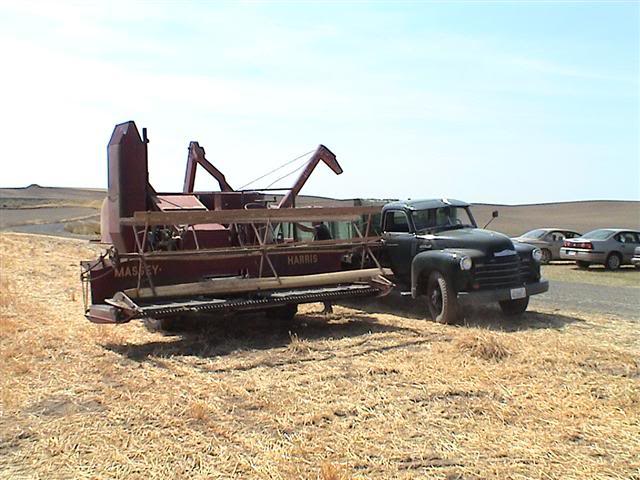The story of the Massey-Harris Harvest Brigade is an interesting one because it combines elements of opportunistic business practices, an honest measure of good will and forward thinking, the creation of an industry, and big cooperation from the government during a time when literally every substance in America was being rationed to help support and supply the war effort abroad. Before we get to talking about the Harvest Brigade though we need to talk about the equipment that made this interesting effort possible, the self-propelled combine.
Prior to the late 1930s, when huge fields had to be harvested the machines available for farmers to use were fairly limited in their ability to move the work along. There was no such thing as a self-propelled harvester before the big Massey-Harris Model 20 of 1938 and even at that, the unwieldy machine was not fit for the smaller farms that made up the primary food source for the country and many parts of the world. The big Model 20 proved that such a device could be built and like all things technological, it was then the job of engineers to refine the package to make the next generation of combine into something more workable for the regular farmer in the USA.
Incidentally, if you are unaware as to where the term “combine” comes from, it was born with the creation of the Model 20 because it was able to “combine” the threshing job with self-propulsion.
The Massey-Harris 21 debuted in very late 1941 or very early 1942 depending on which source you cite. The major problem is that by this time the government had begun to ration materials like steel, engines were tough to come by, rubber was disappearing, and while the people at Massey-Harris knew they had created something that would literally revolutionize American farming, their ability to sell it was evaporating in front of their very eyes and what seemed like an all-out imminent switch to manufacturing war materials would commence soon. Enter Joe Tucker, the sales manager for the Massey-Harris company.
The brilliant Tucker went to work thinking of ways that he could procure the resources needed to continue construction of these groundbreaking machines. He then struck on an idea that would cement his legacy not only in the company but also in the history of American agriculture…the Harvest Brigade. Tucker understood that steel was rationed, fuel was rationed, many farmers and their field workers had shipped overseas, the war production board limited what manufacturers could actually produce, and conversely the need for American crops was more dire around the world than it ever had been. The Harvest Brigade would meet these needs and do it in a way where the war effort would actually come out ahead.
Tucker approached the War Production Board and asked them for an allowance of materials and resources for Massey-Harris to produce 500 combines over their governmentally signed quota. What was his pitch?
Basically, the 500 machines would only be sold to farmers who signed a document guaranteeing that they would harvest at least 2,000 acres with their new combine, Tucker told the government that his machines would prevent a half a million bushels of wheat from being left in the field due to their more thorough processing, he said that the operation would save some half million gallons of fuel and it would free up nearly 1,000 tractors to complete other work on the farms where the combines would be working. The pitch succeeded and the government signed off on the plan. This is just where the story starts to get good.
Knowing that this was an incredible opportunity for their company but also understanding that failure would result in not only bad business fortunes but also a significant setback on the domestic front for the war effort, Massey-Harris went all out. They had men in airplanes flying over wheat fields from Texas to Canada to check the ripening process, they had mechanics, fuel, parts, and virtually everything else they could possibly need stationed along the proposed route that the machines were going to take as they worked their way up the center of the country. Failure was truly not an option at this point and the results were astounding.
Machines began working in Texas and California at nearly the exact same time in May of 1944. By July they had chewed their way through Kansas, Colorado, and Nebraska. August and September saw the combines making their way to the north and knocking on the Canadian border. All along the way the Harvest Brigade was feted in newspapers and magazines with some small exceptions, those mainly being the other manufacturers who were watching hopelessly as Massey-Harris cemented their name into the heads of American farmers and the hearts of the American people, all the while getting more valuable field development time than any competition would get for years FOLLOWING the war. This was a coup of epic proportions for the company.
But for all the pomp and circumstance, did the Harvest Brigade actually do the job? Yes and in spades. The government demanded that a million acres be harvested and by the time they were done the combines had harvested 1.019 million acres. The 25 million bushels of grain delivered exceeded expectations and it was accomplished saving approximately 333,000 man hours and 500,000 gallons of fuel. It worked so good that the program was revived for 1945 as well. It worked so good that an industry that still thrives to this day was born from it. Custom harvesting.
The idea that owning the equipment and charging a fee to harvest another farmer’s crops so that he did not have to pay the big dollars to buy his own stuff was not 100% new when the Harvest Brigade went on their journey in 1944 but this proved that with good planning and coordination it could be a profitable enterprise and businesses began to spring up to provide the service in the years following this first large scale exercise in fully mechanized harvesting. There are massive operations today that have their roots in this 1944 adventure.
While some can certainly question the “purity” of Tucker’s motives, the reality is that he saw a situation where everyone (except his direct competition) could come out ahead and he went for it. The long term benefits to his company verge on the immeasurable because Massey-Harris was so far ahead of everyone else, they owned the combine business for years and years. They had such a technological lead that John Deere didn’t release a combine until 1947 just because it took that long to design something that could compete with the evolving Masseys.
We love stories like this and it speaks to an era where the goals of the country were aligned and things happened at a speed an efficiency that we could nary ever expect today. Another example of gearhead ingenuity at work!



















